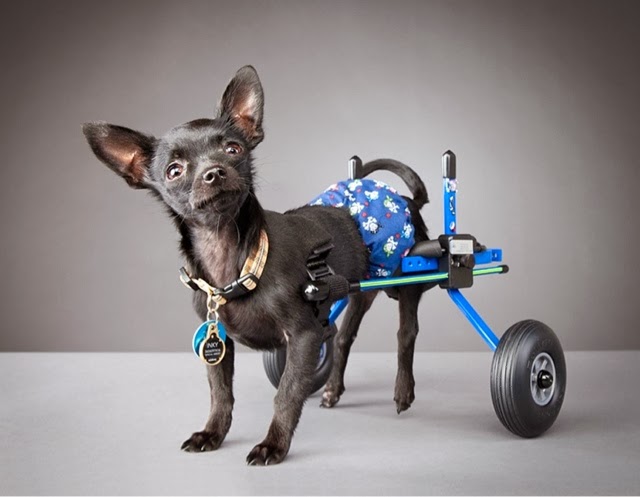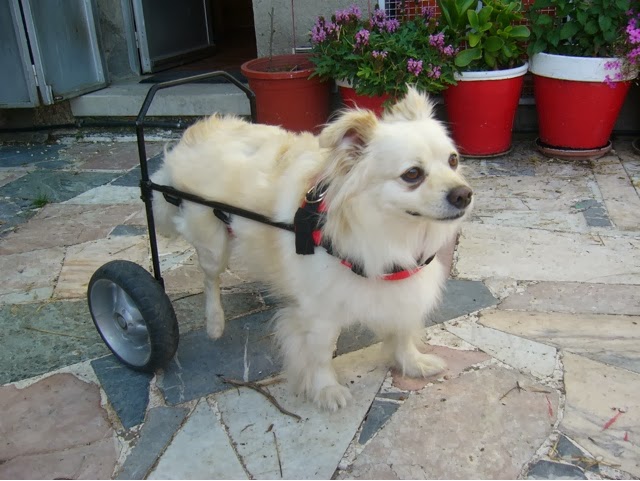Cuando un perro sufre un accidente, una enfermedad o incluso un maltrato, que les provoca una incapacidad, suelen adaptarse rápidamente a la nueva situación. No pasan por un periodo de depresión por la pérdida como les ocurre a las personas sino que de forma asombrosamente rápida aprenden a manejarse con su nueva situación. Es una cuestión de supervivencia.
Generalmente se produce un daño neurológico, bien por traumatismo, bien degenerativo, que conduce a la pérdida del control de las patas traseras e incluso del control de esfínteres por lo que necesitarán ayuda para realizar sus necesidades.
Los dueños de perros que pasan por esto hacen todo lo posible para ayudarles y para que la adaptación de su querida mascota sea más fácil y cómoda. Para esta situación se han desarrollado unas ruedas que permiten sujetar el peso de las patas y que les ayuda a desplazarse con más comodidad y con menos lesiones, ya que al arrastrar las patas traseras se producen heridas por el rozamiento. También hay unas correas que permiten ayudar al perro a sujetar el peso de sus patas traseras.
A pesar de que ver un perrito discapacitado suele provocar ternura y lástima, lo que deberiamos sentir es admiración por la entereza con la que asimilan su nuevo estado y por su capacidad de adaptación y superación.
When a dog suffers an accident, disease or even a mistreatment, which provoked a disability, tend to quickly adapt to the new situation. They do not pass through a period of depression for the loss as people but surprisingly quickly they learn to manage with their new situation. It is a question of survival.
Usually when a neurological damage occurs, because of a degenerative problem or trauma damage, which leads to the loss of control of the back legs and even the sphincters control, they will need much help.
The owners of dogs that pass through this do everything possible to help the dog and try to do the adaptation of their beloved pets easier and more comfortable. For this situation some special wheels have been developed that allow the dog to fasten the weight of the legs and helps them to move more comfortably and with less injuries, since dragging back legs, injuries are caused by friction. There are straps that allow the owner to help the dog to hold the weight of their hind legs.
To see a disabled dog tends to cause tenderness and pity, but what we should feel is admiration for the fortitude with which they assimilate its new status and its capacity of adaptation and improvement.
Y este es Sombra, el perrito de mi amiga Mª Luz. Sombra tuvo un problema neurológico del que tuvo que ser intervenido quirúrgicamente, pero desgraciadamente la operación no obtuvo el resultado deseado y a pesar de la rehabilitación y los masajes, no pudo recuperarse y mover las patas traseras. Para ayudarle decidieron hacerle un "carrito" para favorecer la movilidad. Por casa no le gustaba utilizarlo pero por la calle no le quedaba más remedio porque si no se provocaba heridas, a pesar que para prevenir daños Mª Luz le vendaba las patitas.
And this one is Sombra, the little dog of my friend M ª Luz. Sombra had a neurological problem of which he had to be controlled surgically, but unfortunately the operation did not obtain the wished result and in spite of the rehabilitation and the massages, could not recover and move the back legs. To help him they decided to do a "cart" to favor the mobility. At home he did not like to use it but in the street he had necessarily to use it because to drag the legs could cause wounds, even though M ª Luz used to bandage the legs to him.
Fotos Carli Davidson, Eddie's wheels




















No hay comentarios :
Publicar un comentario